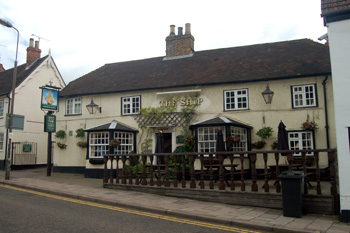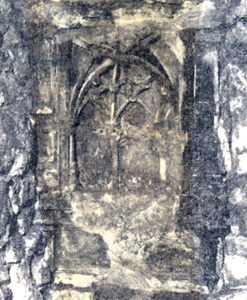The Ship Saint Cuthberts Bedford

The Ship Inn, May 2009
The Ship Inn: 7 St.Cuthbert's Street, Bedford
The Ship is quite an old building. It was listed by the former Department of Environment in 1971 as Grade II, of special interest, and described as being of 17th or 18th century date. However, the building incorporates some much other material as the Bedfordshire Times of 28th July 1957 described: "Recently in the course of alterations being carried out by a firm of local contractors in one of the front rooms of the Ship Inn, St. Cuthbert's, Bedford, some extremely interesting medieval masonry came to light".
"The builder's men had removed the bricks covering an old fireplace when they discovered that it was constructed of ancient stone, some of it bearing the mason's marks; in the embrasure of the east wall was revealed a niche which, on closer examination by Mr. F. W. Kuhlicke, F. S. A. was pronounced to be 1450-60 work. It represents, in miniature, a vaulted church or chapel with small roseate bosses. Careful cleaning later revealed that this beautiful piece of work bore traces of its original colouring in red, blue, green and gold".
"Mr. Kuhlicke formed the theory that it may have formed part of an elaborate shrine or reredos, closely resembling fragments of contemporary craftsmanship in St. Paul's Church, Bedford".
"On the other embrasure is a section of carved and coloured stone which may be either a boss from a roof-vaulting, or the capital of a column of about the same period, or possibly a little earlier, than the niche. Other fragments of an ecclesiastical type included some chamfered coigns, and grooved portions of pilaster".
"In Mr. Kuhlicke's opinion the stone is not old enough to have been part of the church that was demolished to strengthen Bedford Castle; neither can it be supposed to have been taken from the Church of St. Cuthbert that was demolished about 1845 and rebuilt in 1847. This argument points to a possibility that the stonework is of the church that was rebuilt after the destruction of the Castle in 1224, and had fallen into ruin. This St. Cuthbert's church belonged to Dunstable Priory and at the Dissolution the Priory, of course, lost it, as they did the church of Saint Peter de Dunstable, on what is now St. Mary's Square".
"Mr. G. D. Gilmore, who has also inspected the stonework, thinks it is part of the original building on the site of the Ship which may have been erected at any time after the suppression of Newnham Priory. He states that the Newnham Rental, when it was compiled in 1506, showed no building on the site. The part of a column may have come from St. Peter de Dunstable, also the niche, possibly from the porch of the church, since this arch springs in such a way as to suggest an over-hang which would protect a saint's statue from the weather".
"Other relics found in the fireplace included a pair of climbing-irons for the use of boys sent up to clean the chimney, and two 17th century clay pipes".

A medieval carving discovered at the Ship in 1957
The earliest reference to the Ship by name in any document in Bedfordshire Archives occurs in the 18th century. In determining a history of the building it is important not to become confused by two other Ships in the town, one in Saint Paul's Square the other, still extant at the time of writing [2009] in Bromham Road.
The Ship in Saint Cuthbert's Street is first mentioned in 1765 when James Chamberlain devised it in his will to his wife Mary and, after her death, to Ann, wife of Thomas Coleman of Ampthill (presumably their daughter) [ref: ABP/W1767/52 and GK108/12]. The will was proved in 1767.
Nearly a hundred years before, in 1681, a cottage in Saint Cuthbert's was mortgaged by Thomas Lane, a Bedford pipemaker [ref: GK108/1]. In 1732 he conveyed it to another Bedford pipemaker, Thomas Simpson [ref: GK108/4], which raises the question of whether there was a small pipe making workshop on the premises. Simpson devised the cottage in his will of 1729, proved 1732, to his wife Martha and, after her death, another Martha, daughter of his brother William [ref: GK108/9]. Martha the widow, later granted the orchard adjoining her cottage to a Bedford cordwainer John Smith and Martha, his wife (her niece by marriage) [ref: GK108/11]. Martha the widow later married William Phillips of Bedford, fisherman (fishing in the Great Ouse was a commercial enterprise in the 18th century) and she and her niece Martha and her husband James Smith conveyed two cottages in Bedford, Saint Cuthbert's, to James Chamberlain the elder of Bedford, victualler and alderman in 1758 [ref: GK108/13].
It seems likely that one of these cottages became the Ship and the other the washhouse described as formerly a small cottage in 1820. A victualler was a food shop keeper or a keeper of an inn which sold meals. The first time the name appears, as we have seen, is nine years later and it seems reasonable the Chamberlain, a victualler, bought the properties with the idea of turning them into a drinking establishment. It therefore seems likely that the modern public house dates from about 1758, albeit the property is older.
Interestingly a James Chamberlain was noted in a deed as occupying an inn called the Ship in Saint Paul's Square owned by a Richard Cave in 1762 [ref: BD786-787]. Perhaps he already leased the Saint Paul's property when he purchased the cottages in Saint Cuthbert's and decided to set up in premises he owned in competition, using the same name to draw away goodwill trade (deeds can be notoriously out of date when referring to the occupiers of properties to which they refer meaning he was not necessarily still at the Saint Paul's premises in 1762).
In 1805 the devisees in the will of James Chamberlain and the heiresses of Martha Coleman together conveyed the Ship to William Briggs of Bedford [ref: GK108/14]. Five years later Briggs sold the Ship to Bedford brewers Peregrine Nash and his son George Peregrine Nash for £660 [ref: GK108/19]. Peregrine Nash had purchased St.Mary's Brewery in Bedford in 1783 on a site dating back to 1671 and in 1810 he took his son into partnership. Ten years later, in 1820, Peregrine conveyed the business and all its licensed premises, including the Ship to his son [ref: X380/35]. In the conveyance the inn was described thus: "Ship Inn and detached washhouse, lately a small messuage of dwelling house, in Bedford Saint Cuthbert, with garden or orchard adjoining, all late in the occupation of William Briggs now Joseph Baxter".
George Peregrine Nash's eldest son George Peregrine Nash II was taken on as a partner by his father in 1820 but he died in 1844 and was replaced by Nash's second son William Joseph, who was the sole owner of the business by 1849 and by 1870 he owned forty two public houses. The new Steam Brewery in Lurke Street, Bedford was completed in 1875, the old St.Mary's Brewery being pulled down the following year. W. J. Nash died in 1884 leaving only a widow, Susan who took William Pritzler Newland into partnership in 1890. Newland and his partner Frederick Thomas Young owned the Duck Mill Brewery in Bedford. In 1876 his partnership with Young was dissolved and he formed Newland & Company with 15 houses. His partnership with Susan Newland thus created a business with two breweries and fifty seven tied houses. The new business was called Newland & Nash. Newland immediately closed his Duck Mill Brewery, moving to Nash's larger Steam Brewery in Lurke Street. On Susan Nash's death her four daughters became partners and the company was floated in 1897 with 75 public houses as Newland and Nash Limited. William Pritzler Newland died three years later. By 1922 the company was failing, despite buying a number of small breweries in the east of the county. In that year it was purchased by Biggleswade brewers Wells and Winch, the Lurke Street Brewery closing in 1924. Wells and Winch were, themselves, taken over by Suffolk brewers Greene King in 1961.
On a May night in 1863 local solicitor Frederick William Budd was set upon in Castle Lane and beaten so badly that he later died. He was helped by a group of soldiers one of whom was billeted at the Ship and was last seen, with his civilian companion, climbing over the gates. The Ship was also the scene of a murder in 1883 when a young woman was shot in the paddock at the back on the premises.
The Bedfordshire Times reported a fire at the Ship on 11th June 1918: "Shortly after midnight on Monday, Mr Sam Nutt, of the "Ship" St. Cuthbert's, was awakened by a strong smell of smoke, and proceeding downstairs found the small bar on the premises in flames. The fire brigade were informed, and prior to their arrival Mr. Nutt and P. C. Moseley did some good work with a patent fire extinguisher. A first-aid appliance from a standpipe opposite the house gave the outbreak its quietus. Considerable damage was done to the stock of spirits, cigars and glass".
List of Licensees: note that this is not a complete list; entries in italics refer to licensees where either beginning or end, or both, dates are not known:
1765-1767: James Chamberlain;
1805-1810: William Briggs;
1820-1823: Joseph Baxter;
1823-1844: George Ward;
1847: Susannah Ward;
1850-1864: John Torr;
1867-1869: Thomas Gascoin;
1877-1885: Edward Peacock;
1890-1900: John Austin Peacock [convicted of selling beer during prohibited hours on 12 Mar 1894 - fined 5/- with 11/- costs];
1900-1947: Samuel Nutt [cautioned for allowing children in the bar on 30 Jan 1913];
1947-1957: Herbert William Cross;
1965-1967: Frederick Charles William Robinson;
1967-1979: Ralph Mason
List of sources at Bedfordshire Archives:
- GK108/1: Mortgage of a cottage in Saint Cuthbert's: 1681
- GK108/4: Cottage conveyed by Thomas Lane: 1710
- GK108/9: Will of Thomas Simpson devising the house "in which I dwell": 1729, proved 1732
- GK108/11: Grant by Martha Simpson of orchard adjoining her cottage: c.1733
- GK108/13: Two cottages in Saint Cuthbert's conveyed: 1758
- ABP/W1767/52 and GK108/12: Will of James Chamberlain devising the Ship: 1765 proved 1767
- GK108/14: Conveyed to William Briggs of Bedford: 1805
- GK108/19: Conveyed to Peregrine Nash and George Peregrine Nash: 1810
- X380/35: Ship, with other properties, conveyed from Peregrine Nash to George Peregrine Nash:1820
- X418/7: Abuttal in a deed: 1810
- CL/P13: Lists of alehouse licences: 1822-1828
- PSBB1/1: Licensing minutes of Bedford Borough Petty Sessions: 1840-1844;
- Z1005/1/1/14: Auction sale held at the Ship: 1853
- GK161/3: Ship, amongst other properties, mortgaged by William Joseph Nash: 1867
- GA2149 and X65/36: Auction sale held at the Ship: 1874
- GK161/5: Ship, amongst other properties, mortgaged by William Nash: 1882;
- Bedfordshire Mercury: report on the murder of Eleanor McKay and suicide of Hubert Vere: 21 Jul 1883
- GK161/8: Ship, amongst other properties, mortgaged by Susannah Nash and William Pritzler Newland: 1892
- GK3/1a; Ship amongst other properties conveyed to Newland and Nash Limited: 1897
- GK3/1b: Trust deed to secure debenture stock for Newland & Nash: 1897
- AD1082/4: Newspaper cutting of a fire at the Ship: 1918
- GK3/3: Schedule of deeds dating back to 1810: 1936
- Bedford Old & New p.20 (1957)
- Z678/35: Photograph: 1950s
- BorB/PH1/34: Photograph: 1960s
- Z678/57: Photograph: 1983
- BorB/TP/90/1390: Plans of extensions to saloon bar and toilets: 1990
- BorB/TP/92/0960/LB: Plans to renovate an outbuilding: 1992